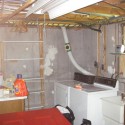
I’m going to be putting in closed-cell spray foam insulation. The big advantage here is the minimal space required – 3″ is over R-20, and it can fit in a 2×4 framed wall.
To start with , here’s a couple shots of what I ripped out.
Half of the basement had some old insulation that had an R-value of maybe R-7. It also had an integrated paper vapour barrier, which is not very effective.
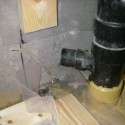
Since the house has only one bathroom, we decided adding a second half-bath to the basement would be a good investment, as well as a useful addition to us right now.
When we moved in, there was an existing sink in the laundry room, which I’m pretty sure was the old kitchen sink and cabinets. I took this picture after I had taken down several cabinets (I unfortunately did not take very many ‘before’ photos), but there were two big cabinets mounted right above the sink before.
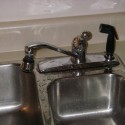
A relatively simple thing we did was replace the kitchen faucet. The kitchen was renovated fairly recently (within the last 10 years), so there is not a lot we were planning on doing with it. The old faucet was leaking from the handle a bit when turned on, and a bit ugly. It was also a bit short for the sink, making it hard to fill up pots etc sometimes.
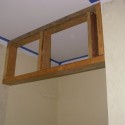
I haven’t been posting updates very regularly, but I have been quite busy working on my house.
One of the non-basement projects I’ve (half) completed is the front hall closet. For some reason, I didn’t take a before photo, but basically it had a bi-fold door that went all the way to the ceiling, 8′ high, with no header. It also didn’t open very smoothly, which I later figured out was because it was mounted to an old floor underneath the carpet, so it didn’t really have room for the carpet at the bottom.
I just came across Google Charts API. This is basically a chart rendering engine that lives at Google, that you can use to render any piece of arbitrary data and display it. Very cool, and a quick and easy way to make nice looking charts, without having to install/buy a charting library.
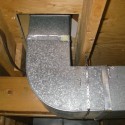
The main heating duct for the house entered the crawlspace by running down the side of the wall directly in front of the stairs. This meant there was a large protrusion into the room in front of the stairs, which just kind of annoyed me because it just seemed in the way, and contributed a bit to the basement feeling smaller. It also annoyed me because it looked to me like it would be easy to run the duct underneath a space in the stairs directly ahead of where it currently ran down the wall — which is exactly what I did.

I’ve spent the last few days (well, longer than that, really) pondering what the exact layout will be for the basement. So here is what it was when I first bought the house:
You can see some pictures of it in this post
The old kitchen cabinets, including the old sink, was moved into the laundry room at some point, in addition to the laundry sink already there. Behind the cabinet, a few inches away from the wall, is the main waste water pipe for the house.

After running network cables the next step, of course, is to terminate them.
Using one of the old cabinets that happened to be close to the right size, I built a rudimentary 19″ rack. It’s not too bad for a DIY rack, especially considering a small swing-out metal rack costs around $250.
I basically took an old cabinet, cut the middle shelf out and turned the whole thing on its side.
Jeff Atwood made a post today talking about the benefits of coding using Javascript frameworks. It totally echos my own thoughts and experiences on it, namely that I used to hate writing client-side code because javascript was so terrible. After discovering first Prototype + Script.aculo.us, and then completely moving to jQuery, my outlook has completely changed. I really do enjoy writing client-side code now. It’s easy, and the results are among the most immediate real programming results you can get, because it runs right there in your browser.
Several times, I’ve come across the need for inheriting constructors in .NET, and I am constantly annoyed that it does not work. I’m writing a business objects layer, and what I’m trying to do is create some constructors in the base class that can initialize the objects in many different ways, eg:
<br /> Public Sub New() ' Create new object using default storage<br /> Public Sub New(ByVal storage as Storage) ' Create new object using specified storage<br /> Public Sub New(ByVal conditions as String, ByVal parameters() as Object) ' Load an object by the specified query, using default storage<br /> Public Sub New(ByVal storage as Storage, ByVal conditions as String, ByVal parameters() as Object) ' Load an object by the specified query<br /> Public Sub New(ByVal id as Object) ' Load an object by the specified primary key, using default storage<br />
 I’m going to be putting in closed-cell spray foam insulation. The big advantage here is the minimal space required – 3″ is over R-20, and it can fit in a 2×4 framed wall.
To start with , here’s a couple shots of what I ripped out.
Half of the basement had some old insulation that had an R-value of maybe R-7. It also had an integrated paper vapour barrier, which is not very effective.
I’m going to be putting in closed-cell spray foam insulation. The big advantage here is the minimal space required – 3″ is over R-20, and it can fit in a 2×4 framed wall.
To start with , here’s a couple shots of what I ripped out.
Half of the basement had some old insulation that had an R-value of maybe R-7. It also had an integrated paper vapour barrier, which is not very effective. Since the house has only one bathroom, we decided adding a second half-bath to the basement would be a good investment, as well as a useful addition to us right now.
When we moved in, there was an existing sink in the laundry room, which I’m pretty sure was the old kitchen sink and cabinets. I took this picture after I had taken down several cabinets (I unfortunately did not take very many ‘before’ photos), but there were two big cabinets mounted right above the sink before.
Since the house has only one bathroom, we decided adding a second half-bath to the basement would be a good investment, as well as a useful addition to us right now.
When we moved in, there was an existing sink in the laundry room, which I’m pretty sure was the old kitchen sink and cabinets. I took this picture after I had taken down several cabinets (I unfortunately did not take very many ‘before’ photos), but there were two big cabinets mounted right above the sink before. A relatively simple thing we did was replace the kitchen faucet. The kitchen was renovated fairly recently (within the last 10 years), so there is not a lot we were planning on doing with it. The old faucet was leaking from the handle a bit when turned on, and a bit ugly. It was also a bit short for the sink, making it hard to fill up pots etc sometimes.
A relatively simple thing we did was replace the kitchen faucet. The kitchen was renovated fairly recently (within the last 10 years), so there is not a lot we were planning on doing with it. The old faucet was leaking from the handle a bit when turned on, and a bit ugly. It was also a bit short for the sink, making it hard to fill up pots etc sometimes. I haven’t been posting updates very regularly, but I have been quite busy working on my house.
One of the non-basement projects I’ve (half) completed is the front hall closet. For some reason, I didn’t take a before photo, but basically it had a bi-fold door that went all the way to the ceiling, 8′ high, with no header. It also didn’t open very smoothly, which I later figured out was because it was mounted to an old floor underneath the carpet, so it didn’t really have room for the carpet at the bottom.
I haven’t been posting updates very regularly, but I have been quite busy working on my house.
One of the non-basement projects I’ve (half) completed is the front hall closet. For some reason, I didn’t take a before photo, but basically it had a bi-fold door that went all the way to the ceiling, 8′ high, with no header. It also didn’t open very smoothly, which I later figured out was because it was mounted to an old floor underneath the carpet, so it didn’t really have room for the carpet at the bottom. The main heating duct for the house entered the crawlspace by running down the side of the wall directly in front of the stairs. This meant there was a large protrusion into the room in front of the stairs, which just kind of annoyed me because it just seemed in the way, and contributed a bit to the basement feeling smaller. It also annoyed me because it looked to me like it would be easy to run the duct underneath a space in the stairs directly ahead of where it currently ran down the wall — which is exactly what I did.
The main heating duct for the house entered the crawlspace by running down the side of the wall directly in front of the stairs. This meant there was a large protrusion into the room in front of the stairs, which just kind of annoyed me because it just seemed in the way, and contributed a bit to the basement feeling smaller. It also annoyed me because it looked to me like it would be easy to run the duct underneath a space in the stairs directly ahead of where it currently ran down the wall — which is exactly what I did. I’ve spent the last few days (well, longer than that, really) pondering what the exact layout will be for the basement. So here is what it was when I first bought the house:
You can see some pictures of it in this post
The old kitchen cabinets, including the old sink, was moved into the laundry room at some point, in addition to the laundry sink already there. Behind the cabinet, a few inches away from the wall, is the main waste water pipe for the house.
I’ve spent the last few days (well, longer than that, really) pondering what the exact layout will be for the basement. So here is what it was when I first bought the house:
You can see some pictures of it in this post
The old kitchen cabinets, including the old sink, was moved into the laundry room at some point, in addition to the laundry sink already there. Behind the cabinet, a few inches away from the wall, is the main waste water pipe for the house. After running network cables the next step, of course, is to terminate them.
Using one of the old cabinets that happened to be close to the right size, I built a rudimentary 19″ rack. It’s not too bad for a DIY rack, especially considering a small swing-out metal rack costs around $250.
I basically took an old cabinet, cut the middle shelf out and turned the whole thing on its side.
After running network cables the next step, of course, is to terminate them.
Using one of the old cabinets that happened to be close to the right size, I built a rudimentary 19″ rack. It’s not too bad for a DIY rack, especially considering a small swing-out metal rack costs around $250.
I basically took an old cabinet, cut the middle shelf out and turned the whole thing on its side.